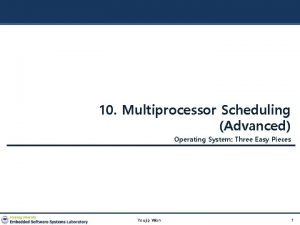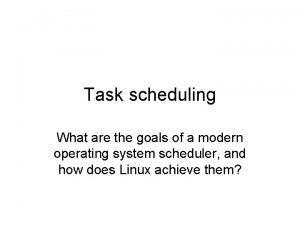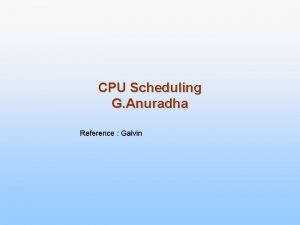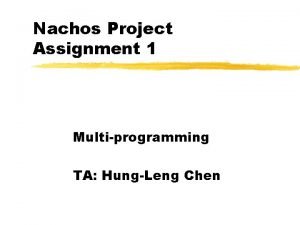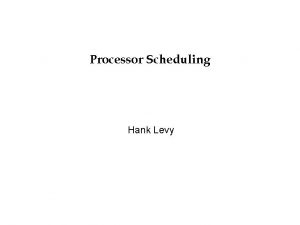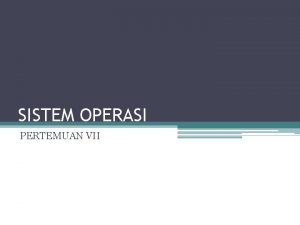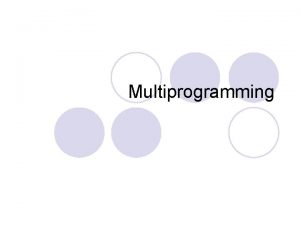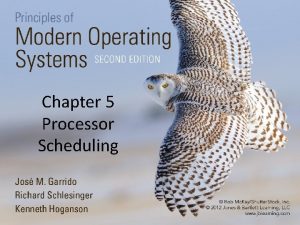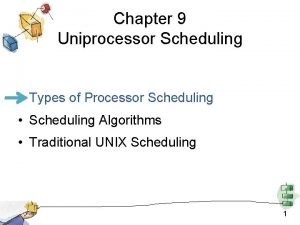Processor Scheduling Goals for Multiprogramming In a multiprogramming









- Slides: 9

Processor Scheduling

Goals for Multiprogramming • In a multiprogramming system, we try to increase utilization and thruput by overlapping I/O and CPU activities. • This requires several os policy decisions: – determine the multiprogramming level -- the number of jobs loaded in primary memory – decide what job is to run next to guarantee good service • These decisions are long-term and short-term scheduling decisions, respectively. • Short-term scheduling executes more frequently, changes of multiprogramming level are more costly. 11/23/2020 2

Scheduling • The scheduler chooses processes to run from the ready queue. • The scheduling algorithm determines how jobs are scheduled. • In general, the scheduler runs: – when a process switches from running to waiting – when an interrupt occurs – when a process is created or terminated • In a preemptive system, the scheduler can interrupt a process that is running. • In a non-preemptive system, the scheduler waits for a running process to explicitly block 11/23/2020 3

Scheduling Algorithms • There are many possible criteria for evaluating a scheduling algorithm: – – – CPU utilization thruput turnaround time waiting time response time • In an interactive system, predictability may be more important than a low average but high variance. 11/23/2020 4

Scheduling Algorithms • First-come First-served (FCFC) (FIFO) – jobs are scheduled in order of arrival to ready Q – typically non-preemptive • Problem: – average waiting time can be large if small jobs wait behind long ones time B Job A B C C Job A – may lead to poor overlap of I/O and CPU 11/23/2020 5

Scheduling Algorithms • Shortest Job First (SJF) – choose the job with the smallest (expected) CPU burst – provability optimal min. average waiting time • Problem: – impossible to know size of CPU burst (but can try to predict from previous activity) • Can be either preemptive or non-preemptive • Preemptive SJF is called shortest remaining time first 11/23/2020 6

Scheduling Algorithms • Priority Scheduling – choose next job based on priority – for SJF, priority = expected CPU burst – can be either preemptive or non-preemptive • Problem: – starvation: jobs can wait indefinitely • Solution to starvation – age processes: increase priority as a function of waiting time 11/23/2020 7

Scheduling Algorithms • Round Robin – – used for timesharing in particular ready queue is treated as a circular queue (FIFO) each process is given a time slice called a quantum it is run for the quantum or until it blocks • Problem: – context switch overhead of frequent context switch 11/23/2020 8

Scheduling Algorithms • Multi-level Queue • Implement multiple ready Qs based on job “type” – – – interactive process CPU-bound process batch job system processes editing session • Different Qs may be scheduled using different algorithms • Jobs move from Q to Q (feedback loop) • Very general algorithm, but need to select parameters for: # of queues, sched. Algs. , when to upgrade a job, when to downgrade a job, when to start a new job. 11/23/2020 9
 Strategic goals tactical goals operational goals
Strategic goals tactical goals operational goals Strategic goals tactical goals operational goals
Strategic goals tactical goals operational goals Multiprocessor scheduling in operating system
Multiprocessor scheduling in operating system Sjn scheduling
Sjn scheduling What are the goal(s) for process scheduling?
What are the goal(s) for process scheduling? General goals and specific goals
General goals and specific goals Examples of generic goals and product-specific goals
Examples of generic goals and product-specific goals Ics and multiprogramming
Ics and multiprogramming What is the objective of multiprogramming? *
What is the objective of multiprogramming? * Nachos project
Nachos project


